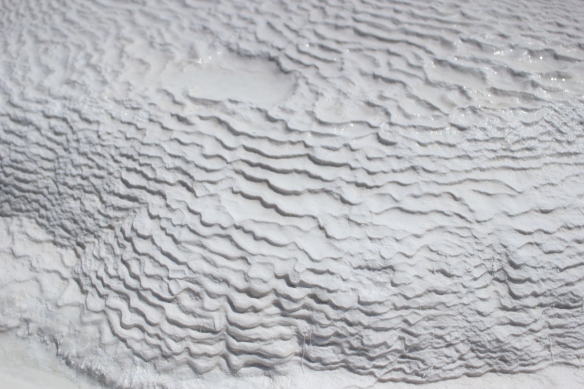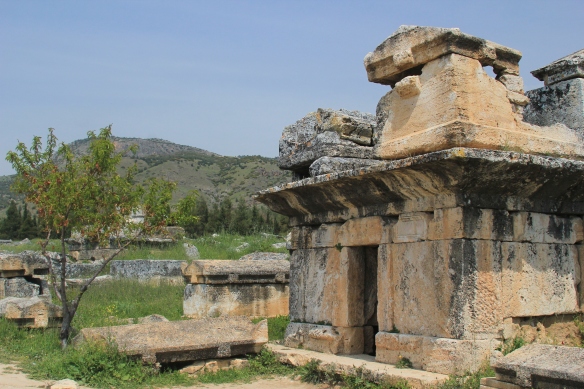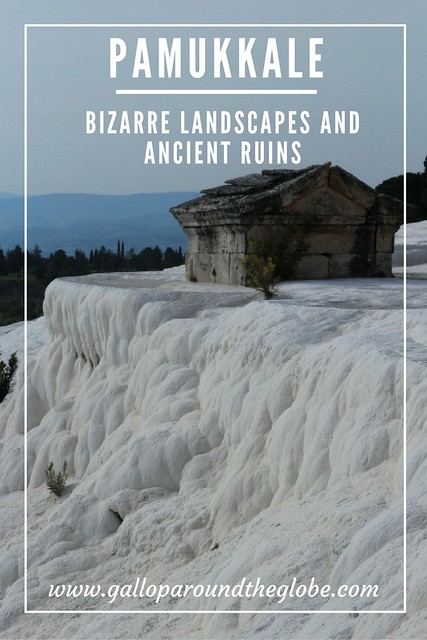So I’d decided that Turkey would be my next destination to explore, partly because it was one of the closest and cheapest places to get to that would be relatively hot in April, and partly because family and friends had been continually telling me how much I would love Istanbul. They were right. I loved the vibrant, buzzing, colourful city, I loved the charming neighbourhoods, the stunning mosques, and the wonderful markets and bazaars. But Turkey is such a vast country with so many diverse and beautiful landscapes, that I couldn’t possibly pass up the opportunity to venture outside of Istanbul to see some of them.
I toyed with the idea of visiting Ephesus – and don’t get me wrong, that’s still somewhere I’d love to find myself one day – but I’ve seen a lot of ruins, yet I’ve never seen such unusual landscapes as Cappadocia and Pamukkale presented.
I arrived in Pamukkale following a long but surprisingly comfortable overnight bus journey from Istanbul and a breakfast of sweaty cheese and broken crackers. Arriving here was almost like I’d stepped back in time – a lone tractor chugged along the road and inquisitive children hung around on dustry street corners. Yet already I was falling in love with this place…the tranquility of the lush green countryside that surrounded me, the relaxed pace of life, and the freshness of the air in every breath I took.
I love cities, I love how alive they make me feel, but when I come to somewhere like Pamukkale – somewhere so far removed from city life, it brings a whole new dimension to that sense of feeling alive. There’s nothing quite like standing on top of a mountain, with the wind on your face and the crisp mountain air in your lungs, and that humbling moment when you look around and see the vast, beautiful landscapes that surround you.
When we arrived at our hotel, it seemed to embody everything that we’d found Pamukkale to be so far…a beautiful oasis of calm. We walked through the gates of the Melrose House Hotel into a lovely shaded seating area with marble floors, wicker tables and chairs, and traditional Turkish style lanterns hanging from its wooden ceilings. To the left was an inviting pool and garden, thoughtfully landscaped with plants and flowers, and backed by the beauty of Pamukkale’s countryside.
As we’d arrived so early, we had to wait an hour or so for our room to be prepared, so we took advantage of the free coffee offered to us by the welcoming and accommodating owners, sat down by the pool in the early morning sunshine, and affectionately petted the resident cats. I’m a self-confessed cat lover, so the fact that there were three of the adorable little feline creatures here, meant that I immediately felt at home.
An hour or so later, we strolled into town in search of Pamukkale’s main (and possibly only) attraction – its hot springs and travertines; terraces of carbonate minerals left by the flowing water. We brought a map with us, which we soon realised was completely superfluous to our needs, as Pamukkale is barely a three-street village. The travertines form a stunning backdrop to its sleepy streets, like mountains covered in fresh snow.
Spotting a tortoise carelessly wandering along one of Pamukkale’s ‘main’ roads (which we later discovered was to be the first of many of these curious creatures we encountered – in the wild, as it were) made a random interlude to our short walk up to the southern entrance.
Pamukkale means “Cotton Castle” in Turkish, and as you get closer to this stunning, bizarre and unusual attraction, you can see why. I didn’t really have any expectations about the place before I arrived, but I’d seen numerous photographs of the unique terraces and pools, and I was interested to see them for myself.
What I saw, having paid my 20TL to enter the site and removed my shoes and socks (as is obligatory for any visitor), was on a much larger scale than I’d ever imagined. Stretching high above the town itself, the travertines spread for almost 2 miles across the Turkish countryside.
The gleaming white calcite shelves, overrunning with mineral-rich warm waters from the mountains above, are actually naturally formed (although parts of the site are now man-made). However, had the site not obtained Unesco World Heritage status back in 1998, and a subsequent plan put in place to protect it, those unique travertines could well have been a natural phenomena ruined by the intervention of man.
Bathing is now only permitted in the lower pools, and there are ‘police’ scattered around the site at the top, who appear like ninjas, to stop rebellious tourists venturing into the upper pools. I say ninjas because you cannot see them right up until that moment that you’ve stepped just a little too far across in order to home in on that perfect shot that you see on all the postcards. Whilst I do wholly respect the rule and the definite need for it, in my defence it’s difficult to tell where the boundaries are, so on this occasion I was guilty as charged!
It’s a strange sensation walking through the pools and over the travertines. The water is beautifully warm, and the ground beneath it is soft, even gooey in places. However, in between the pools, the constant water flow can make the ground rather slippery so you do have to take care if you’re not wearing swimming gear and you’re carrying an expensive camera (like I was!).
 As we climbed the terraces, we amused ourselves by watching children playfully splashing around in the pools and girls posing for their boyfriends, draping themselves seductively over the terraces in skimpy bikinis. We even witnessed a couple having their wedding photographs taken at the top of the pools.
As we climbed the terraces, we amused ourselves by watching children playfully splashing around in the pools and girls posing for their boyfriends, draping themselves seductively over the terraces in skimpy bikinis. We even witnessed a couple having their wedding photographs taken at the top of the pools.
Whilst Turkey’s “Cotton Castle” is a unique and very beautiful landscape, I’m not sure how the white dress against the backdrop of the dazzling white travertines would have worked on camera. But hey, I’m sure the photographer knew what he was doing!
As you reach the top of the climb, the land levels out. The travertines up here are a lot more pristine and made for some wonderful photographs on our way back down, as the sun lay lower in the sky and had begun to create those lovely reflections in the pools.
The site shut at 6pm the day we visited, so unfortunately I missed out on what would have been some awe-inspiring sunset photographs across the terraces.
Located high above Pamukkale and on the same site as the village’s travertines and hot springs, Hierapolis (meaning ‘Sacred City’ in Greek) was founded as a thermal spa in the second century BCE, and subsequently became a healing centre where doctors used the thermal pools as a treatment for their patients.
The ruins cover a vast area and include grand entrance gates, columned streets and baths, as well as a sacred pool, Basilica, Temple, Latrine, Amphitheatre, and a sprawling Necropolis.
We spent a whole day here marvelling at the landscape…
Paddling in the hot pools…
Climbing the ruins…
Looking for lizards…
and taking an enormous amount of photographs – a few of which were silly ones we simply couldn’t resist!
It’s very evident that money has been spent on the upkeep of this site. It’s been landscaped beautifully, with a wooden walkway running around its circumference, giving easy access to all areas.
Not many tourists seem to venture very far along the walkway at the top, preferring to bathe in the pools nearer to the bottom, explore the ruins, or mooch around taking photographs of the views.
However if you continue along the walkway as it wraps its way around the perimeter of the hillside, there are some spectacular sights to be seen. There is less water up here, and in parts the terraces are completely dry due to the fact that the water is regularly diverted from one side of the valley to the other, in order to give the calcium carbonate a chance to harden and form travertines.
It’s really interesting to see how the whole operation comes together, and just how much work has been done to keep the site what it is today.
Right at the end of the walkway, near to the northern entrance of the site (which is the jumping off point for Hierapolis) is a real gem in my opinion…a monumental tomb that is partially submerged in the dry calcium carbonate. It’s positioned right on the edge of the hillside and is one of the most bizarre sights I’ve ever encountered.
I’d thoroughly enjoyed my time exploring the site of Hierapolis and its terraces and hot springs. Yes, I’d travelled all the way from Istanbul just to witness this bizarre landscape but it was so totally and utterly worth it.
Footnotes
We stayed at the Melrose Hotel, which I can thoroughly recommend for the friendly, helpful staff, and quality of the accommodation and food.
If you like this article, please share it on social media using the share buttons at the top of the post. Alternatively you can follow along on Facebook, Twitter, or Google+ or you can look me up on Instagram or Pinterest too!






























No Comments